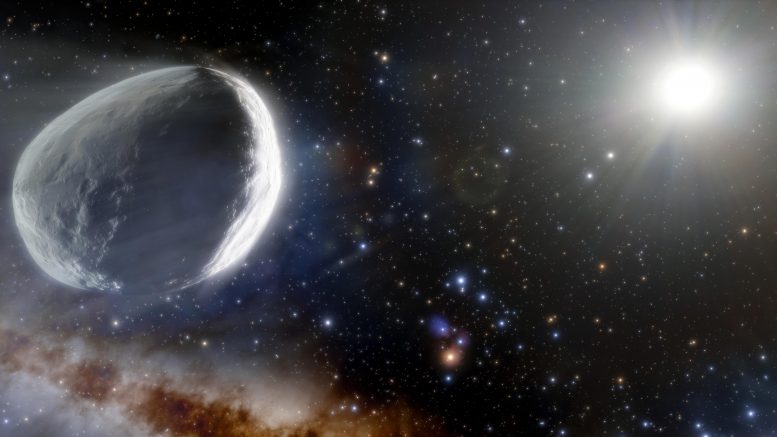Astronomers Discover Largest-Known Comet Was Active at Near-Record Distance
The Comet Bernardinelli-Bernstein (BB), represented in this artist’s rendition as it might look in the outer Solar System, is estimated to be about 1000 times more massive than a typical comet. The largest comet discovered in modern times, it is among the most distant comets to be discovered with a coma, which means ice within the comet is vaporizing and forming an envelope of dust and vapor around the comet’s core. Credit: NOIRLab/NSF/AURA/J. da Silva
University of Maryland astronomers discovered that comet Bernardinelli-Bernstein is among the most distant active comets from the sun, providing key information about its composition.
The largest comet ever discovered became active much farther from the sun than previously believed, according to a new study by University of Maryland astronomers.
Only one other active comet—meaning one that has formed an envelope of dust and vapor known as a coma—has been observed farther from the sun; however, it was much smaller than comet Bernardinelli-Bernstein (BB), which at 100 km in diameter dwarfs every other known comet by a hefty margin. (Halley’s comet, by comparison, is 15 km in diameter, while 1 km is typical.)
The finding, which will help astronomers determine what BB is made of and provide insight into conditions that existed billions of years ago during the formation of our solar system, was published on November 29, 2021, in The Planetary Science Journal.
“These observations are pushing the distances for active comets dramatically farther than we have previously known,” said Tony Farnham, a research scientist in the UMD Department of Astronomy and the lead author of the study.
Often called “dirty snowballs” or “icy dirtballs,” comets are conglomerations of dust and ice left over from the solar system’s early days. How warm they must be to start vaporizing as their orbit carries them closer to the sun depends on what kind of ice they contain: water, carbon dioxide, carbon monoxide or some other frozen compound.
Scientists first discovered comet BB beyond the orbit of Uranus in June using data from the Dark Energy Survey, an international effort to survey the sky over the Southern Hemisphere. It captured the bright nucleus of the comet but did not have high-enough resolution to reveal the envelope of dust and vapor that forms when the comet becomes active.
When Farnham heard about the discovery, he immediately wondered if images of comet BB had been captured by the Transient Exoplanet Survey Satellite (TESS), which observes one area of the sky for 28 days at a time. He thought TESS’s longer exposure times could provide more detail.
Farnham and astronomy colleagues including Research Professor James Bauer and Associate Research Scientist Michael Kelley combined thousands of images of comet BB collected by TESS from 2018 through 2020. By stacking them, Farnham was able to increase the contrast and get a clearer view of the comet. But because comets move, he had to layer the images so that comet BB was precisely aligned in each frame. That technique removed any errant specks from individual shots while amplifying the image of the comet, which allowed researchers to see the hazy glow of dust surrounding BB, proof that BB had a coma and was active.
Reference: “Early Activity in Comet C/2014 UN271 Bernardinelli–Bernstein as Observed by TESS” by Tony L. Farnham, Michael S. P. Kelley and James M. Bauer, 29 November 2021, The Planetary Science Journal.
FROM SCITECHDAILY 30/11/2021

Δεν υπάρχουν σχόλια:
Δημοσίευση σχολίου